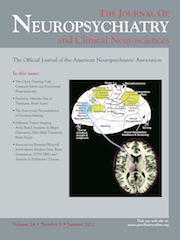Increased Anterior Cingulate Regional Homogeneity After Duloxetine Therapy in First-Episode, Drug-Naïve, Major Depressive Disorder With Panic Disorder Patients: A Case Series
To the Editor: Regional homogeneity (ReHo) represents the synchronization and coordination of resting-state functional magnetic resonance (RFMRI).1 Here, we present five cases of first-episode, drug-naïve, major depressive disorder (MDD) with panic disorder (PD), which showed increases of ReHo over the anterior cingulate cortex (ACC) after remission with duloxetine therapy for 6 weeks.
Case Series
Five patients (three women, two men; 26.6 [SD: 4.56] years old) were enrolled. Their baseline rating data were as follows: Hamilton Rating Scale for Depression (Ham-D): 28.8 (4.6) and Panic Disorder Severity Scale (PDSS): 19.8 (4.32). No specific physical illness, psychotic features, past manic episodes, nonpsychiatric medication use, or substance abuse were mentioned. The treatment of duloxetine 30 mg/day was initiated, with titration to 60 mg within 2 weeks without any significant side effects except mild nausea and sedation. After a 6-week therapy, their MDD and PD symptoms responded to duloxetine (Ham-D: 8.2 [3.83]; PDSS: 3.4 [1.67]).
RFMRI scans were obtained with a 3T GE Version scanner housed at Buddhist Tzu Chi Hospital, Taipei Branch. Echo planar imaging (EPI) sequences were acquired in 20 axial slices (TR: 2,000 msec., TE: 40 msec., flip angle: 90°, FOV: 24 cm.; 5-mm. thickness, and 1-mm gap; 400 sec. for each subject) at baseline and 6th-week visit. The preprocessed RFMRI data were processed by REST (Resting State FMRI Data Analysis Toolkit, Version 1.4) to produce ReHo map image files by using default mask with cluster greater than 27 voxels. Each ReHo map was divided by its own mean ReHo within the mask for standardization purposes. The modulated ReHo map image files were then smoothed by FWHM 4 × 4 × 4 Gaussian kernel to reduce noise and residual differences in the gyral anatomy. The subsequent group-comparison analysis between baseline and 6th week was performed (second-level random effects model, paired t-test). There were modest increases of ReHo in the ACC region of these remitted patients after duloxetine treatment (uncorrected p<0.00005; cluster voxel threshold >10; volume >270 mm3; rmm: 6, with corner-connected hypothesis; Figure 1).

Discussion
Mannie et al.2 have reported that young adults with a family history of MDD did not have activation of ACC like that of healthy controls while performing emotional counting Stroop tasks. In this case series, ACC ReHo increased in remitted patients after duloxetine therapy. The ACC ReHo enhancement probably represented modulation of previous ACC decreased activities while in the depressive phase, and the phenomenon was accompanied by remission of MDD. ACC is important for the resolution of response conflicts, and this region plays an important role in MDD pathogenesis. Antidepressants possibly increase the correlations of RFMRI between ACC and limbic regions, and it might suggest that antidepressants can restore the decreased connection between ACC and limbic regions through the enhancement of cortical mood-regulating regions over primitive emotional regions.3
PD is also associated with neurotransmitter abnormalities4 and structural deficits5 in the ACC. The ReHo changes in ACC after remission of MDD and PD symptoms could be explored in future studies.
1 : Regional homogeneity approach to fMRI data analysis. Neuroimage 2004; 22:394–400Crossref, Medline, Google Scholar
2 : Affective modulation of anterior cingulate cortex in young people at increased familial risk of depression. Br J Psychiatry 2008; 192:356–361Crossref, Medline, Google Scholar
3 : Antidepressant effect on connectivity of the mood-regulating circuit: an FMRI study. Neuropsychopharmacology 2005; 30:1334–1344Crossref, Medline, Google Scholar
4 : Decreased GABA levels in anterior cingulate and basal ganglia in medicated subjects with panic disorder: a proton magnetic resonance spectroscopy (1H-MRS) study. Prog Neuropsychopharmacol Biol Psychiatry 2007; 31:403–411Crossref, Medline, Google Scholar
5 : First-episode, drug-naïve, major depressive disorder with panic disorder: gray-matter deficits in limbic and default network structures. Eur Neuropsychopharmacol 2010; 20:676–682Crossref, Medline, Google Scholar



